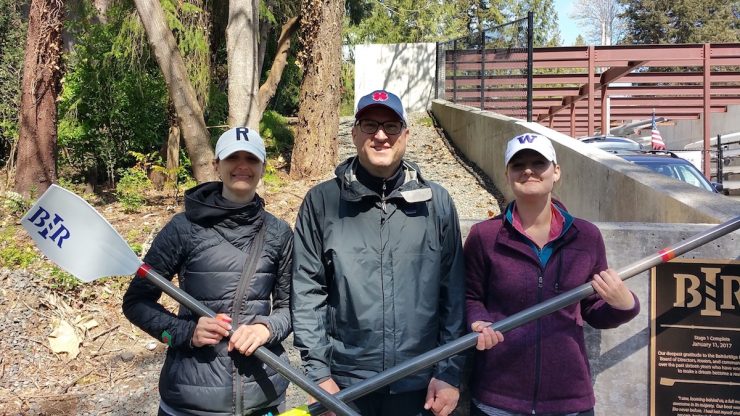Andrea Forbush, Larry McGrail, and Janet Duxbury know how. A bunch of your neighbors know how. The Bainbridge Island Rowing masters and juniors know how. Do you? Don’t worry if you haven’t yet learned to row: Bainbridge Island Rowing’s Learn to Row program for 2018 is up and rowing.
BIR just offered its first Weekend Intensive Learn to Row session. The three aforementioned people persevered through normal Northwest spring weather conditions of wind, rain, and sun. And now they’re graduates who know things like what Way ’nuff means and how to feather and how not to catch a crab. They certainly feel more at ease living on an island. And they feel connected to the marine ecosystem that surrounds us.
But knowing how to row isn’t just about understanding the techniques and concepts of the sport. Samir Becic, author of ReSYNC Your Life, identifies these health reasons to take up rowing:
- It promotes healthy body composition. Rowing can burn up to 600 calories per hour, which means that the extra helping of chowder fries is a given.
- It enhances the respiratory and cardio systems. With just 30 minutes of rowing you can improve your lungs’ and heart’s ability to get oxygen to the rest of your body.
- It offers low impact exercise with high results. Name another sport that involves all major muscle groups without the damage of high impact. Marcia Desanctis in her article “Rowing Is a Full-Body Workout You Can Do at Any Age” (Town & Country, June 23, 2017), explains: “Because the motion is not fully weight-bearing, crew is great for people with knee or shoulder problems—even ones who, like me, have had joint replacement surgery.”
- It reduces stress. The combination of rhythmic activity with being outdoors AND being on the water contribute to lowering stress. Desanctis puts it this way: “. . . rowing has a meditative effect, with its rhythmic motion and surreal quiet, apart from breathing, faint splashes, and the whir of the seat rolling back and forth.”
- It stabilizes the body. Becic explains that rowing fires up the stabilizer and neutralizer muscles, which help you manage off-balanced movement.
- It improves muscle and joint mobility. Because rowing safely conditions many different muscles and joints, it minimizes stiffness and increases flexibility.
And it’s more than health benefits that make rowing worthwhile. In her article “Five Lessons I’ve Learned from Rowing,” Caroline Adams Miller explains how rowing teaches great life lessons. She writes, “In swimming, if you don’t show up for a practice, or you are late, you hurt no one but yourself. On the other hand, if you are expected to be at practice in crew and you don’t show up, the boat can’t go out and everyone’s day is compromised as a result.” The lesson is: If you want to succeed, you need to be there for others.
She also learned that harmonious relationships lead to success—specifically, winning when it comes to rowing. The sport also looks down on teammate criticism. Coaches tell you to “Row your seat and not anyone else’s.” Adams Miller also learned that rowing’s focus on getting the fundamentals right before tackling the larger things is a lesson that translates to other life areas as well.
Finally, she finds in rowing a lesson on the importance of learning to listen and follow a leader. Since rowers don’t look where they’re going and instead rely on the coxswain’s commands, they develop trust and the ability to follow when it really matters.
Another rower, Carolyn Croke, identifies five completely different life lessons she gleaned from rowing. In her article, “What Rowing Taught Me About Life,” she lists these:
- Perfect practice makes perfect.
- You don’t have to be a captain to lead a team.
- You can be overqualified for a seat and still not make the boat. Which means, she writes, “Now I know that, in the future, if I don’t get a job based on my resume that someone else fit the position better so I need to find a different way to improve myself so I can get the job I want.”
- You can give everything you have in a race and come up short.
- Your team will be where you meet your best friends.
- If you truly love the sport, it will love you back.
What are you waiting for? You live where the water is, in a marine environment, on the rugged seas once rowed by Suquamish, Duwamish, Nisqually, Snoqualmie, and Muckleshoot peoples as well as salty sailors, explorers, and immigrants. Get out there. You owe it to yourself.
Find out more about the Bainbridge Island Rowing Learn to Row Program.





